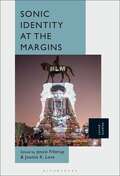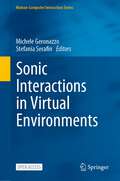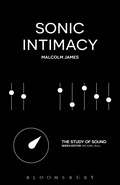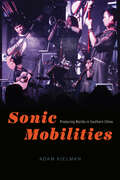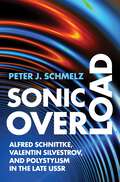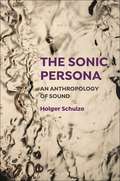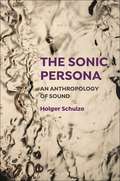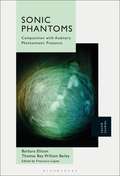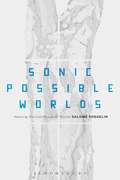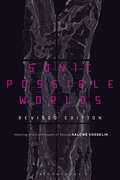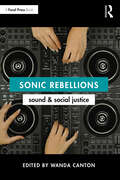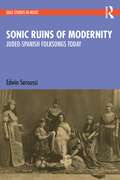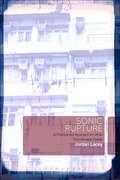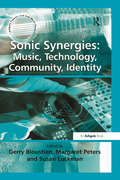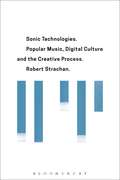- Table View
- List View
Sonic Identity at the Margins
Sonic Identity at the Margins convenes the interdisciplinary work of 17 academics, composers, and performers to examine sonic identity from the 19th century to the present. Recognizing the myriad aspects of identity formation, the authors in this volume adopt methodological approaches that range from personal accounts and embodied expression to archival research and hermeneutic interpretation. They examine real and imagined spaces-from video games and monument sites to films and depictions of outer space-by focusing on sonic creation, performance, and reception. Drawing broadly from artistic and performance disciplines, the authors reimagine the roles played by music and sound in constructing notions of identity in a broad array of musical experiences, from anti-slavery songsters to Indigenous tunes and soundscapes, noise and multimedia to popular music and symphonic works. Exploring relationships between sound and various markers of identity-including race, gender, ability, and nationality-the authors explore challenging, timely topics, including the legacies of slavery, indigeneity, immigration, and colonial expansion. In heeding recent calls to decolonize music studies and confront its hegemonic methods, the authors interrogate privileged perspectives embedded in creating, performing, and listening to sound, as well as the approaches used to analyze these experiences.
Sonic Interactions in Virtual Environments (Human–Computer Interaction Series)
by Michele Geronazzo Stefania SerafinThis open access book tackles the design of 3D spatial interactions in an audio-centered and audio-first perspective, providing the fundamental notions related to the creation and evaluation of immersive sonic experiences. The key elements that enhance the sensation of place in a virtual environment (VE) are:Immersive audio: the computational aspects of the acoustical-space properties of Virutal Reality (VR) technologies Sonic interaction: the human-computer interplay through auditory feedback in VEVR systems: naturally support multimodal integration, impacting different application domainsSonic Interactions in Virtual Environments will feature state-of-the-art research on real-time auralization, sonic interaction design in VR, quality of the experience in multimodal scenarios, and applications. Contributors and editors include interdisciplinary experts from the fields of computer science, engineering, acoustics, psychology, design, humanities, and beyond. Their mission is to shape an emerging new field of study at the intersection of sonic interaction design and immersive media, embracing an archipelago of existing research spread in different audio communities and to increase among the VR communities, researchers, and practitioners, the awareness of the importance of sonic elements when designing immersive environments.
Sonic Intimacy: Reggae Sound Systems, Jungle Pirate Radio and Grime YouTube Music Videos (The Study of Sound)
by Malcolm James'Sonic intimacy' is a key concept through which sound, human and technological relations can be assessed in relation to racial capitalism. What is sonic intimacy, how is it changing and what is at stake in its transformation, are questions that should concern us all. Through an analysis of alternative music cultures of the Black Atlantic (reggae sound systems, jungle pirate radio and grime YouTube music videos), Malcolm James critically shows how sonic intimacy pertains to modernity's social, psychic, spatial and temporal movements. This book explores what is urgently at stake in the development of sonic intimacy for human relations and alternative black and anti-capitalist public politics.
Sonic Intimacy: Reggae Sound Systems, Jungle Pirate Radio and Grime YouTube Music Videos (The Study of Sound)
by Malcolm James'Sonic intimacy' is a key concept through which sound, human and technological relations can be assessed in relation to racial capitalism. What is sonic intimacy, how is it changing and what is at stake in its transformation, are questions that should concern us all. Through an analysis of alternative music cultures of the Black Atlantic (reggae sound systems, jungle pirate radio and grime YouTube music videos), Malcolm James critically shows how sonic intimacy pertains to modernity's social, psychic, spatial and temporal movements. This book explores what is urgently at stake in the development of sonic intimacy for human relations and alternative black and anti-capitalist public politics.
Sonic Mobilities: Producing Worlds in Southern China (Chicago Studies in Ethnomusicology)
by Adam KielmanA fascinating look at how the popular musical culture of Guangzhou expresses the city’s unique cosmopolitanism. Guangzhou is a large Chinese city like many others. With a booming economy and abundant job opportunities, it has become a magnet for rural citizens seeking better job prospects as well as global corporations hoping to gain a foothold in one of the world’s largest economies. This openness and energy have led to a thriving popular music scene that is every bit the equal of Beijing’s. But the musical culture of Guangzhou expresses the city’s unique cosmopolitanism. A port city that once played a key role in China’s maritime Silk Road, Guangzhou has long been an international hub. Now, new migrants to the city are incorporating diverse Chinese folk traditions into the musical tapestry. In Sonic Mobilities, ethnomusicologist Adam Kielman takes a deep dive into Guangzhou's music scene through two bands, Wanju Chuanzhang (Toy Captain) and Mabang (Caravan), that express ties to their rural homelands and small-town roots while forging new cosmopolitan musical connections. These bands make music that captures the intersection of the global and local that has come to define Guangzhou, for example by writing songs with a popular Jamaican reggae beat and lyrics in their distinct regional dialects mostly incomprehensible to their audiences. These bands create a sound both instantly recognizable and totally foreign, international and hyper-local. This juxtaposition, Kielman argues, is an apt expression of the demographic, geographic, and political shifts underway in Guangzhou and across the country. Bridging ethnomusicology, popular music studies, cultural geography, and media studies, Kielman examines the cultural dimensions of shifts in conceptualizations of self, space, publics, and state in a rapidly transforming the People’s Republic of China.
Sonic Mobilities: Producing Worlds in Southern China (Chicago Studies in Ethnomusicology)
by Adam KielmanA fascinating look at how the popular musical culture of Guangzhou expresses the city’s unique cosmopolitanism. Guangzhou is a large Chinese city like many others. With a booming economy and abundant job opportunities, it has become a magnet for rural citizens seeking better job prospects as well as global corporations hoping to gain a foothold in one of the world’s largest economies. This openness and energy have led to a thriving popular music scene that is every bit the equal of Beijing’s. But the musical culture of Guangzhou expresses the city’s unique cosmopolitanism. A port city that once played a key role in China’s maritime Silk Road, Guangzhou has long been an international hub. Now, new migrants to the city are incorporating diverse Chinese folk traditions into the musical tapestry. In Sonic Mobilities, ethnomusicologist Adam Kielman takes a deep dive into Guangzhou's music scene through two bands, Wanju Chuanzhang (Toy Captain) and Mabang (Caravan), that express ties to their rural homelands and small-town roots while forging new cosmopolitan musical connections. These bands make music that captures the intersection of the global and local that has come to define Guangzhou, for example by writing songs with a popular Jamaican reggae beat and lyrics in their distinct regional dialects mostly incomprehensible to their audiences. These bands create a sound both instantly recognizable and totally foreign, international and hyper-local. This juxtaposition, Kielman argues, is an apt expression of the demographic, geographic, and political shifts underway in Guangzhou and across the country. Bridging ethnomusicology, popular music studies, cultural geography, and media studies, Kielman examines the cultural dimensions of shifts in conceptualizations of self, space, publics, and state in a rapidly transforming the People’s Republic of China.
Sonic Overload: Alfred Schnittke, Valentin Silvestrov, and Polystylism in the Late USSR
by Peter J. SchmelzSonic Overload offers a new, music-centered cultural history of the late Soviet Union. It focuses on polystylism in music as a response to the information overload swamping listeners in the Soviet Union during its final decades. It traces the ways in which leading composers Alfred Schnittke and Valentin Silvestrov initially embraced popular sources before ultimately rejecting them. Polystylism first responded to the utopian impulses of Soviet ideology with utopian impulses to encompass all musical styles, from "high" to "low". But these initial all-embracing aspirations were soon followed by retreats to alternate utopias founded on carefully selecting satisfactory borrowings, as familiar hierarchies of culture, taste, and class reasserted themselves. Looking at polystylism in the late USSR tells us about past and present, near and far, as it probes the musical roots of the overloaded, distracted present. Based on archival research, oral historical interviews, and other overlooked primary materials, as well as close listening and thorough examination of scores and recordings, Sonic Overload presents a multilayered and comprehensive portrait of late-Soviet polystylism and cultural life, and of the music of Silvestrov and Schnittke. Sonic Overload is intended for musicologists and Soviet, Russian, and Ukrainian specialists in history, the arts, film, and literature, as well as readers interested in twentieth- and twenty-first century music; modernism and postmodernism; quotation and collage; the intersections of "high" and "low" cultures; and politics and the arts.
Sonic Overload: Alfred Schnittke, Valentin Silvestrov, and Polystylism in the Late USSR
by Peter J. SchmelzSonic Overload offers a new, music-centered cultural history of the late Soviet Union. It focuses on polystylism in music as a response to the information overload swamping listeners in the Soviet Union during its final decades. It traces the ways in which leading composers Alfred Schnittke and Valentin Silvestrov initially embraced popular sources before ultimately rejecting them. Polystylism first responded to the utopian impulses of Soviet ideology with utopian impulses to encompass all musical styles, from "high" to "low". But these initial all-embracing aspirations were soon followed by retreats to alternate utopias founded on carefully selecting satisfactory borrowings, as familiar hierarchies of culture, taste, and class reasserted themselves. Looking at polystylism in the late USSR tells us about past and present, near and far, as it probes the musical roots of the overloaded, distracted present. Based on archival research, oral historical interviews, and other overlooked primary materials, as well as close listening and thorough examination of scores and recordings, Sonic Overload presents a multilayered and comprehensive portrait of late-Soviet polystylism and cultural life, and of the music of Silvestrov and Schnittke. Sonic Overload is intended for musicologists and Soviet, Russian, and Ukrainian specialists in history, the arts, film, and literature, as well as readers interested in twentieth- and twenty-first century music; modernism and postmodernism; quotation and collage; the intersections of "high" and "low" cultures; and politics and the arts.
The Sonic Persona: An Anthropology of Sound
by Holger SchulzeIn The Sonic Persona, Holger Schulze undertakes a critical study of some of the most influential studies in sound since the 19th century in the natural sciences, the engineering sciences, and in media theory, confronting them with contemporary artistic practices, with experimental critique, and with disturbing sonic experiences.From Hermann von Helmholtz to Miley Cyrus, from FLUXUS to the Arab Spring, from Wavefield Synthesis to otoacoustic emissions, from premillennial clubculture to postdemocratic authoritarianism, from signal processing to human echolocation: This book presents a fundamental critique concerning recent sound theories and their anthropological concepts – and proposes an alternate, a more plastic, a visceral framework for research in the field of a cultural anthropology of sounding and listening.This anthropology of sound takes its readers and listeners on a research expedition to the multitude of alien humanoids and their surprising sonic personae: in dynamic and generative tension between predetermined auditory dispositives, miniscule and not seldomly ignored sound practices, and idiosyncratic sensory corpuses: a critique of the senses.I'm going to prove the impossible really exists.
The Sonic Persona: An Anthropology of Sound
by Holger SchulzeIn The Sonic Persona, Holger Schulze undertakes a critical study of some of the most influential studies in sound since the 19th century in the natural sciences, the engineering sciences, and in media theory, confronting them with contemporary artistic practices, with experimental critique, and with disturbing sonic experiences.From Hermann von Helmholtz to Miley Cyrus, from FLUXUS to the Arab Spring, from Wavefield Synthesis to otoacoustic emissions, from premillennial clubculture to postdemocratic authoritarianism, from signal processing to human echolocation: This book presents a fundamental critique concerning recent sound theories and their anthropological concepts – and proposes an alternate, a more plastic, a visceral framework for research in the field of a cultural anthropology of sounding and listening.This anthropology of sound takes its readers and listeners on a research expedition to the multitude of alien humanoids and their surprising sonic personae: in dynamic and generative tension between predetermined auditory dispositives, miniscule and not seldomly ignored sound practices, and idiosyncratic sensory corpuses: a critique of the senses.I'm going to prove the impossible really exists.
Sonic Phantoms: Composition with Auditory Phantasmatic Presence
by Barbara Ellison Thomas Bey BaileyIn this book, Barbara Ellison and Thomas B. W. Bailey lay out and explore the mystifying and evanescent musical territory of 'sonic phantoms': auditory illusions within the musical material that convey a 'phantasmatic' presence. Structured around a large body of compositional work developed by Ellison over the past decade, sonic phantoms are revealed and illustrated as they arise through a diverse array of musical sources, materials, techniques, and compositional tools: voices (real and synthetic), field recordings, instrument manipulation, object amplification, improvisation, and recording studio techniques. Somehow inherent in all music--and perhaps in all sound--sonic phantoms lurk and stalk with the promise of mystery and elevation. We just need to conjure them.
Sonic Phantoms: Composition with Auditory Phantasmatic Presence
by Barbara Ellison Thomas Bey BaileyIn this book, Barbara Ellison and Thomas B. W. Bailey lay out and explore the mystifying and evanescent musical territory of 'sonic phantoms': auditory illusions within the musical material that convey a 'phantasmatic' presence. Structured around a large body of compositional work developed by Ellison over the past decade, sonic phantoms are revealed and illustrated as they arise through a diverse array of musical sources, materials, techniques, and compositional tools: voices (real and synthetic), field recordings, instrument manipulation, object amplification, improvisation, and recording studio techniques. Somehow inherent in all music--and perhaps in all sound--sonic phantoms lurk and stalk with the promise of mystery and elevation. We just need to conjure them.
Sonic Possible Worlds: Hearing the Continuum of Sound
by Salomé VoegelinInspired by its use in literary theory, film criticism and the discourse of game design, Salomé Voegelin adapts and develops “possible world theory” in relation to sound. David K Lewis' Possible World is juxtaposed with Maurice Merleau-Ponty's life-world, to produce a meeting of the semantic and the phenomenological at the place of listening. The central tenet of Sonic Possible Worlds is that at present traditional musical compositions and contemporary sonic outputs are approached and investigated through separate and distinct critical languages and histories. As a consequence, no continuous and comparative study of the field is possible. In Sonic Possible Worlds, Voegelin proposes a new analytical framework that can access and investigate works across genres and times, enabling a comparative engagement where composers such as Henry Purcell and Nadia Boulanger encounter sound art works by Shilpa Gupta and Christina Kubisch and where the soundscape compositions of Chris Watson and Francisco López resound in the visual worlds of Louise Bourgeois.
Sonic Possible Worlds: Hearing the Continuum of Sound
by Salomé VoegelinInspired by its use in literary theory, film criticism and the discourse of game design, Salomé Voegelin adapts and develops “possible world theory” in relation to sound. David K Lewis' Possible World is juxtaposed with Maurice Merleau-Ponty's life-world, to produce a meeting of the semantic and the phenomenological at the place of listening. The central tenet of Sonic Possible Worlds is that at present traditional musical compositions and contemporary sonic outputs are approached and investigated through separate and distinct critical languages and histories. As a consequence, no continuous and comparative study of the field is possible. In Sonic Possible Worlds, Voegelin proposes a new analytical framework that can access and investigate works across genres and times, enabling a comparative engagement where composers such as Henry Purcell and Nadia Boulanger encounter sound art works by Shilpa Gupta and Christina Kubisch and where the soundscape compositions of Chris Watson and Francisco López resound in the visual worlds of Louise Bourgeois.
Sonic Possible Worlds, Revised Edition: Hearing the Continuum of Sound
by Salomé VoegelinFrom its use in literary theory, film criticism and the discourse of games design, Salomé Voegelin expands 'possible world theory' to think the worlding of sound in music, in art and in the everyday. The modal logic of possible worlds, articulated principally via David K. Lewis and developed through Maurice Merleau-Ponty's phenomenological life-worlds, creates a view on the invisible slices of the world and reflects on how to make them count, politically and aesthetically. How to make them thinkable and accessible as the possibility of the everyday and of art: to reach a new materialist understanding from the invisible and to develop an ear for the as yet inaudible.Creating Sonic Possible Worlds, such a phenomenological modality offers a new analytical framework that listens across genres and times to hear the continuum between sound art and music and to grasp the plurality of the world. This revised edition continues Voegelin's exploration of the sonic possibility of the world into the sonic possibility and impossibility of the body. Listening to works by Áine O'Dwyer, Hannah Silva and Jocy de Oliveira, it considers sonic possible worlds' radical power to rethink normative constructions and to fabulate a different body from its sound. Thus, the word continuum in the subtitle of this book, Hearing the Continuum of Sound, which in the first edition stood principally for the continuum between music and sound art, is opened up to denote also another continuum that stands as principle for the body, while including that of sound: Hearing the Continuum Between Plural Bodies Breathing, between humans-humanoid aliens-monsters-vampires-animals-plants-things-and anything we have no name for yet but which a sonic philosophy might start to hear and call.
Sonic Possible Worlds, Revised Edition: Hearing the Continuum of Sound
by Salomé VoegelinFrom its use in literary theory, film criticism and the discourse of games design, Salomé Voegelin expands 'possible world theory' to think the worlding of sound in music, in art and in the everyday. The modal logic of possible worlds, articulated principally via David K. Lewis and developed through Maurice Merleau-Ponty's phenomenological life-worlds, creates a view on the invisible slices of the world and reflects on how to make them count, politically and aesthetically. How to make them thinkable and accessible as the possibility of the everyday and of art: to reach a new materialist understanding from the invisible and to develop an ear for the as yet inaudible.Creating Sonic Possible Worlds, such a phenomenological modality offers a new analytical framework that listens across genres and times to hear the continuum between sound art and music and to grasp the plurality of the world. This revised edition continues Voegelin's exploration of the sonic possibility of the world into the sonic possibility and impossibility of the body. Listening to works by Áine O'Dwyer, Hannah Silva and Jocy de Oliveira, it considers sonic possible worlds' radical power to rethink normative constructions and to fabulate a different body from its sound. Thus, the word continuum in the subtitle of this book, Hearing the Continuum of Sound, which in the first edition stood principally for the continuum between music and sound art, is opened up to denote also another continuum that stands as principle for the body, while including that of sound: Hearing the Continuum Between Plural Bodies Breathing, between humans-humanoid aliens-monsters-vampires-animals-plants-things-and anything we have no name for yet but which a sonic philosophy might start to hear and call.
Sonic Rebellions: Sound and Social Justice
by Wanda CantonSonic Rebellions combines theory and practice to consider contemporary uses of sound in the context of politics, philosophy, and protest, by exploring the relationship between sound and social justice, with particular attention to sonic methodologies not necessarily conceptualised or practiced in traditional understandings of activism.An edited collection written by artists, academics, and activists, many of the authors have multidimensional experiences as practitioners themselves, and readers will benefit from never-before published doctoral and community projects, and innovative, audio-based interpretations of social issues today. Chapters cover the use of soundscapes, rap, theatre, social media, protest, and song, in application to contemporary socio-political issues, such as gentrification, neoliberalism, criminalisation, democracy, and migrant rights. Sonic Rebellions looks to encourage readers to become, or consider how they are, Sonic Rebels themselves, by developing their own practices and reflections in tandem to continue the conversation as to how sound permeates our sociopolitical lives.This is an essential resource for those interested in how sound can change the world, including undergraduates and postgraduates from across the social sciences and humanities, scholars and instructors of sound studies and sound production, as well as activists, artists, and community organisers.
Sonic Rebellions: Sound and Social Justice
Sonic Rebellions combines theory and practice to consider contemporary uses of sound in the context of politics, philosophy, and protest, by exploring the relationship between sound and social justice, with particular attention to sonic methodologies not necessarily conceptualised or practiced in traditional understandings of activism.An edited collection written by artists, academics, and activists, many of the authors have multidimensional experiences as practitioners themselves, and readers will benefit from never-before published doctoral and community projects, and innovative, audio-based interpretations of social issues today. Chapters cover the use of soundscapes, rap, theatre, social media, protest, and song, in application to contemporary socio-political issues, such as gentrification, neoliberalism, criminalisation, democracy, and migrant rights. Sonic Rebellions looks to encourage readers to become, or consider how they are, Sonic Rebels themselves, by developing their own practices and reflections in tandem to continue the conversation as to how sound permeates our sociopolitical lives.This is an essential resource for those interested in how sound can change the world, including undergraduates and postgraduates from across the social sciences and humanities, scholars and instructors of sound studies and sound production, as well as activists, artists, and community organisers.
Sonic Ruins of Modernity: Judeo-Spanish Folksongs Today (SOAS Studies in Music)
by Edwin SeroussiSonic Ruins of Modernity shows how social, cultural and cognitive phenomena interact in the making and distribution of folksongs beyond their time. Through Judeo-Spanish (or Ladino) folksongs, the author illustrates a methodology for the interplay of individual memories, artistic initiatives, political and media policies, which ultimately shape “tradition” for the past century. He fleshes out in a series of case studies how folksongs can be conceived, performed and circulated in the post-tradition era – constituting each song as a “sonic ruin,” as an imagined place. At the same time, the book overall provides a unique perspective on the history of the Judeo-Spanish folksong.
Sonic Ruins of Modernity: Judeo-Spanish Folksongs Today (SOAS Studies in Music)
by Edwin SeroussiSonic Ruins of Modernity shows how social, cultural and cognitive phenomena interact in the making and distribution of folksongs beyond their time. Through Judeo-Spanish (or Ladino) folksongs, the author illustrates a methodology for the interplay of individual memories, artistic initiatives, political and media policies, which ultimately shape “tradition” for the past century. He fleshes out in a series of case studies how folksongs can be conceived, performed and circulated in the post-tradition era – constituting each song as a “sonic ruin,” as an imagined place. At the same time, the book overall provides a unique perspective on the history of the Judeo-Spanish folksong.
Sonic Rupture: A Practice-led Approach to Urban Soundscape Design
by Jordan LaceySonic Rupture applies a practitioner-led approach to urban soundscape design, which foregrounds the importance of creative encounters in global cities. This presents an alternative to those urban soundscape design approaches concerned with managing the negative health impacts of noise. Instead, urban noise is considered to be a creative material and cultural expression that can be reshaped with citywide networks of sonic installations. By applying affect theory the urban is imagined as an unfolding of the Affective Earth, and noise as its homogenous (and homogenizing) voice. It is argued that noise is an expressive material with which sonic practitioners can interface, to increase the creative possibilities of urban life. At the heart of this argument is the question of relationships: how do we augment and diversify those interconnections that weave together the imaginative life and the expressions of the land? The book details seven sound installations completed by the author as part of a creative practice research process, in which the sonic rupture model was discovered. The sonic rupture model, which aims to diversify human experiences and urban environments, encapsulates five soundscape design approaches and ten practitioner intentions. Multiple works of international practitioners are explored in relation to the discussed approaches. Sonic Rupture provides the domains of sound art, music, creative practice, urban design, architecture and environmental philosophy with a unique perspective for understanding those affective forces, which shape urban life. The book also provides a range of practical and conceptual tools for urban soundscape design that can be applied by the sonic practitioner.
Sonic Rupture: A Practice-led Approach to Urban Soundscape Design
by Jordan LaceySonic Rupture applies a practitioner-led approach to urban soundscape design, which foregrounds the importance of creative encounters in global cities. This presents an alternative to those urban soundscape design approaches concerned with managing the negative health impacts of noise. Instead, urban noise is considered to be a creative material and cultural expression that can be reshaped with citywide networks of sonic installations. By applying affect theory the urban is imagined as an unfolding of the Affective Earth, and noise as its homogenous (and homogenizing) voice. It is argued that noise is an expressive material with which sonic practitioners can interface, to increase the creative possibilities of urban life. At the heart of this argument is the question of relationships: how do we augment and diversify those interconnections that weave together the imaginative life and the expressions of the land? The book details seven sound installations completed by the author as part of a creative practice research process, in which the sonic rupture model was discovered. The sonic rupture model, which aims to diversify human experiences and urban environments, encapsulates five soundscape design approaches and ten practitioner intentions. Multiple works of international practitioners are explored in relation to the discussed approaches. Sonic Rupture provides the domains of sound art, music, creative practice, urban design, architecture and environmental philosophy with a unique perspective for understanding those affective forces, which shape urban life. The book also provides a range of practical and conceptual tools for urban soundscape design that can be applied by the sonic practitioner.
Sonic Synergies: Music, Technology, Community, Identity
by Gerry BloustienSonic Synergies: Music, Technology, Community, Identity focuses on the new and emerging synergies of music and digital technology within the new knowledge economies. Eighteen scholars representing six international perspectives explore the global and local ramifications of rapidly changing new technologies on creative industries, local communities, music practitioners and consumers. Diverse areas are considered, such as production, consumption, historical and cultural context, legislation, globalization and the impact upon the individual. Drawing on a range of musical genres from jazz, heavy metal, hip-hop and trance, and through several detailed case studies reflecting on the work of professional and local amateur artists, this book offers an important discussion of the ways in which the face of music is changing. Approaching these areas from a cultural studies perspective, this text will be a valuable tool for anyone engaged in the study of popular culture, music or digital technologies.
Sonic Synergies: Music, Technology, Community, Identity
by Gerry BloustienSonic Synergies: Music, Technology, Community, Identity focuses on the new and emerging synergies of music and digital technology within the new knowledge economies. Eighteen scholars representing six international perspectives explore the global and local ramifications of rapidly changing new technologies on creative industries, local communities, music practitioners and consumers. Diverse areas are considered, such as production, consumption, historical and cultural context, legislation, globalization and the impact upon the individual. Drawing on a range of musical genres from jazz, heavy metal, hip-hop and trance, and through several detailed case studies reflecting on the work of professional and local amateur artists, this book offers an important discussion of the ways in which the face of music is changing. Approaching these areas from a cultural studies perspective, this text will be a valuable tool for anyone engaged in the study of popular culture, music or digital technologies.
Sonic Technologies: Popular Music, Digital Culture and the Creative Process
by Robert StrachanIn the past two decades digital technologies have fundamentally changed the way we think about, make and use popular music. From the production of multimillion selling pop records to the ubiquitous remix that has become a marker of Web 2.0, the emergence of new music production technologies have had a transformative effect upon 21st Century digital culture. Sonic Technologies examines these issues with a specific focus upon the impact of digitization upon creativity; that is, what musicians, cultural producers and prosumers do. For many, music production has moved out of the professional recording studio and into the home. Using a broad range of examples ranging from experimental electronic music to more mainstream genres, the book examines how contemporary creative practice is shaped by the visual and sonic look and feel of recording technologies such as Digital Audio Workstations.
